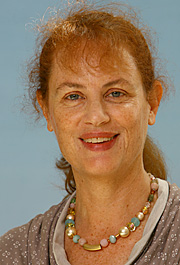By Janis Siegel, JTNews Correspondent
Though it threatened her arrival, volcanic ash clouds from Iceland couldn’t keep Israeli Comparative Literature professor Ilana Pardes from making it to Seattle to deliver her first evening lecture that kicked off the 35th Annual Samuel & Althea Stroum Lectures in Jewish Studies.
There was no need to worry about any pulverized powder deterring her flight, University of Washington Prof. Gad Barzilai, chair of the Stroum Jewish Studies Program and Pruzan Professor of Jewish Studies, jokingly told the nearly full audience at the UW’s Kane Hall, because “the Stroums would take care of business.”
Pardes, a widely recognized scholar, was born and raised in Israel, and has been teaching at the Hebrew University in Jerusalem since 1992. Prior to returning to Israel, she taught at the University of California at Berkeley and Princeton University. Pardes spent last fall at The Center for Judaic Studies in Philadelphia.
“She is the most prominent expert on literal interpretations of the Bible and how the Old Testament has been generated through and reproduced in poetry and literature,” Barzilai told JTNews.
Pardes’ books include Countertraditions in the Bible: A Feminist Approach (Harvard University Press, 1992), The Biography of Ancient Israel: National Narratives in the Bible (University of California Press, 2000), and Melville’s Bibles (University of California, 2008).
In the her first lecture of the series, “Upon the Handles of the Lock: Agnon, Balak, and the Israeli Bible,” Pardes explored the works of S.Y. Agnon, one of Israel’s most prominent authors, who won the Israel Prize in 1954 and the Nobel Prize in 1966, and who died in 1970, to gain a greater understanding of how the Bible is reflected in popular Israeli culture.
“This is really my first plunge into modern Hebrew literature,” Pardes told JTNews. “I always deal with the nexus of Bible, literature and culture, but these are stories and texts from the ‘50s, mostly the Bible, within the Zionist imagination, explored through Agnon. I’m investigating my own culture, the culture of my childhood.”
Born Shmuel Yosef Czaczkes in 1888 to an observant Jewish family in Buczacz, Galicia, S.Y. Agnon, learned biblical texts, rabbinical commentary and Hassidic literature as a youth through his formal education and through the influence of his father, a rabbi, while his mother introduced him to German philosophical writings.
As an adult, he became interested in Zionism and emigrated to Palestine in 1907, joining the secular literati of the day there, before moving to Berlin, where he befriended other great writers including Martin Buber, Franz Rosensweig and Gershom Sholem.
Having established a close friendship with both Rosensweig and Sholem, the three writers debated the sacredness of the Hebrew language and considered whether a more secular interpretation of biblical texts wouldn’t better reflect the character and ideology belonging to those Zionists who resettled the land.
“It is as though he were saying,” imagined Pardes in her prepared remarks, “‘Since you will not accept the continuity of tradition and its language in their true context, take them in the transformation which they have undergone in my work. Take them from someone who stands at the crossroads and can see from both directions.’”
In another work, Agnon reinterpreted the classical biblical book about love, “Song of Songs,” traditionally understood to be a metaphor of the love that God has for Israel. Agnon recast the themes of the story in secular Zionist tones that reflected the ideology of the then-fledgling country’s founders.
This romantic and celebratory narrative, said Pardes, is put on a pedestal in the writings of those who resettled the land.
“‘The Song of Songs’ is sort of an exemplary text,” Pardes told JTNews. “It has its own special status within secular Zionism. That’s why I chose it.”
Agnon, according to Pardes, interpreted the love poem as a “new national allegory…providing modern forms of collective love, primarily the love between the community and the land.”
“This was a shift from the biblical text to questions about the Bible itself in modern literature and modern culture,” Pardes added. “This is a formative moment that I’m dealing with, but of course, it has implications for contemporary culture.”
Pardes’ second lecture was titled “Agnon’s Ethnographies of Love and the Quest for the Ultimate Song.”
This year, the Stroum series introduced a new format for the third lecture. Pardes’ final presentation, “Freud, Zipporah, and the Bridegroom of Blood: National Ambivalence in the Bible” was held in a new “learn-in” format, which was reserved for educators, and UW faculty and students. All future series will feature this new format. Organizers hope this more intensive option, which came in response to past series attendees who said they wanted more time with the lecturer and the material, will allow for additional interactivity and questions.
“Three lectures in this day and age are too much,” said Jennifer Cohen, assistant director for the Samuel & Althea Stroum Jewish Studies Program. “We want people to feel that they are part of a learning community — that’s what we’re trying to create.”
A Web site set up by the UW’s Stroum Jewish Studies Program, www.stroumlectures.org, has further information and audio recordings of Pardes’ lectures.
